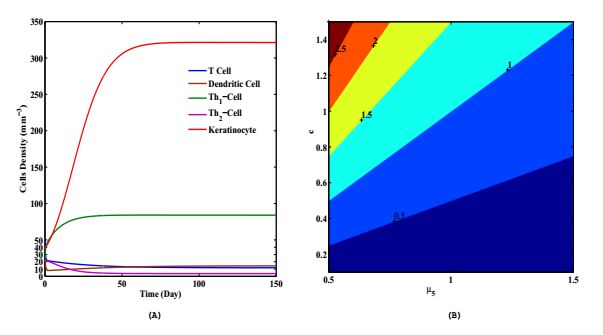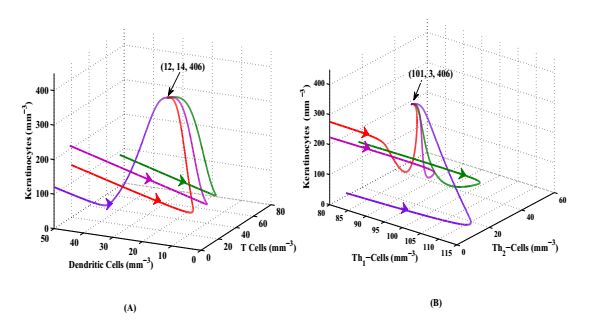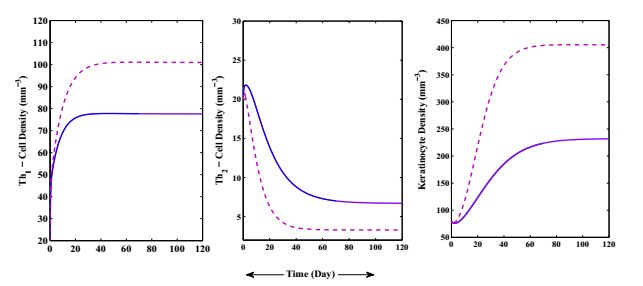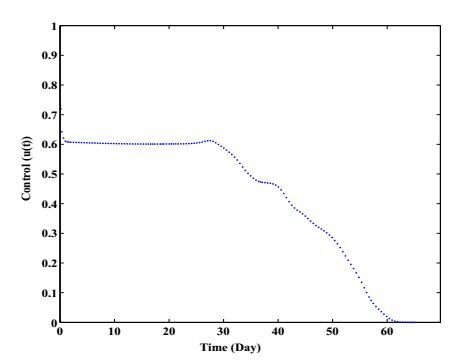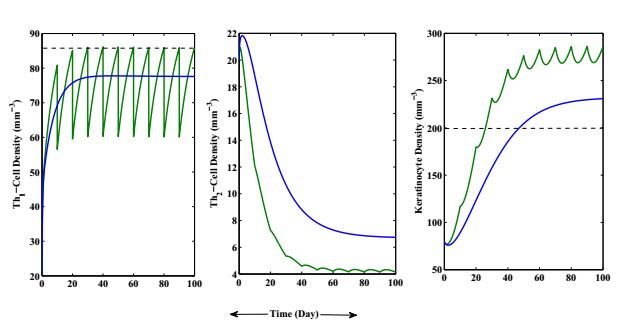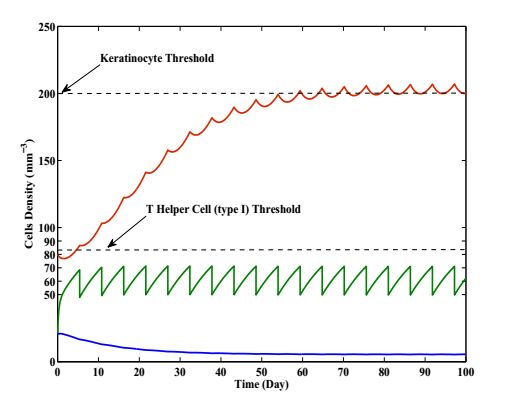1. Introduction
Psoriasis is a chronic, immune modulated autoimmune disease that affects the skin with localized inflammation reactions. It is one of the complicated and persistent skin disorders encountered till date. About 2−3% individuals worldwide are suffering from this irritating skin disease. The common form of this disease is chronic plaque Psoriasis which occurs in nearly 90% of cases [1,2]. Psoriasis is a special condition of the dermal layers where hyper-proliferation of Keratinocytes (skin cells) is chaotic due to interference's within immune cell signaling.
Basal Keratinocytes of dermis during cellular differentiation gradually migrates to the skin surface and forms the outermost layer. This process is highly synchronized by various co-stimulation factors within the immune cells. In the presence of Co-stimulation molecules cytokine secretion is more pronounced by T Cells [3,4]. Immune cell proliferation and polarization in organized pattern is controlled by the cytokine milieu. Cytokines are special messenger molecules secreted by immune cells and are associated with the cellular signal transduction, trafficking and its modulation to impose activation or suppression of immune system. Naive T Cells, after originated from bone marrow through thymus undergo a differentiation with interaction of DCs post-synapse to produce Th1 and Th2 subtypes [5,6] under selected cytokine milieu. It is interesting to know that the synaptic locks are short transient initially lasting from a few minutes to hours but in long run it can develop stable T-DC synapse to initiate a T Cell polarization [7]. Psoriatic hyper-proliferation of Keratinocytes is expressed by anomalous balance of immune cell activation and differentiation e.g., T Cells, Dendritic Cells, Th1-Cells and Th2-Cells [5,6] and its associated signal cascade elevating the Keratinocyte growth. The synaptic interactions may often produce asymmetric T Cell division and functional diversity of T Cell heterogeneity [10]. The enhancement of Keratinocytes population through different cytokine signaling by the immune cells is illustrated in Figure 1. Under IL−12 over crowded signaling molecules, T Cell differentiates into large amount of Th1-Cells that secretes pro-inflammatory cytokines viz. IFN−γ, TGF−β and TNF−α [11]. The role of TGF−β differs with its target cell types. Keratinocytes has been shown to be a significant target tissue of TGF−β and it differentiates by the influence of TGF−β signaling [12]. Under IFN−γ cytokine environment macrophages are activated and also stimulated to increase cellular activity [5]. Psoriasis is pronounced by Th1-Cells disorder, characterized by the production of IFN−γ, TNF−α and TGF−β under the effect of cytokine IL−12 [13]. TNF−α alone cannot elicit immunologic reaction although secreted from T Cell and APC but can raise a cytokine storm when combined with strong synergism with IL−17a [14]. Recent studies suggest that if the periphery environment is IL−4 dominated at the time of naive T Cells activation, it results in enhancement of the density of Th2-Cells. Cytokines expressed by each subset positively regulate itself and negatively regulate the other subset either in paracrine or autocrine signals [11,15]. IL−4 exerts pleiotropic effects on the immune system and may directly suppress Th1-mediated inflammation by converting the T helper cell phenotype into Th2-Cells [16,17,18]. It is reported that IL−10 cytokine promote the enlargement of an anti-inflammatory cytokines configuration by inhibiting the IFN−γ production of T Cells and natural killer cells particularly via the conquest of IL−12 synthesis in adjunct cells [19]. Although anti-inflammatory cytokines secreted from Th2-Cells negatively regulate the Keratinocytes population [20,21]. High level secretion of Th1 mediated cytokines, generalized as pro-inflammatory cytokines are responsible for aggravating psoriatic lesion [6,21].
During the last few decades, widespread clinical and experimental investigations are being done for diagnosis of Psoriasis. Rapid cell cycle duration of psoriatic cell division elevates to 28 fold (35000 cells/day in lieu of 1246 cells/day) as estimated by Weinstein et al. following [22]. Baker et al. have already found that pro-inflammatory cytokine plays a significant role in this uncontrolled psoriatic cell division and also they shown that IFN−γ is found at raised levels in psoriatic skin [23]. TNF−α has been secreted as a emergency or early psoriatic stages delivering inflammatory influence on the epidermal layers. Nockowski et al. observed that the concentrations of TGF−β were significantly increased in level for patients with Psoriasis [24]. For psoriatic patients, Alefacept, Efalizumab, Etanercept, Infliximab and Adalimumab are most commonly used drugs and are active TNF−α blockers [25]. Recently, cytokine induced treatment for psoriatic patients is majorly suggested by many biological or clinical experimentalist proposing that the anti-inflammatory cytokine (IL−4 and IL−10) injecting may be a plausible treatment for Psoriasis [17,26]. IL−10 can be administered subcutaneously as described by Tzu et al. [27]. Clinical studies have demonstrated that IL−10 reduces Th1-type cytokine levels and induced remission of Psoriasis [26]. Numerous studies have suggested the efficacy of recombinant human IL−10 (rhIL−10) in decreasing the Psoriasis activity and achieving long-term remissions [28,29,30,31,32]. Although a lot of experimental and clinical studies were performed yet a unified exploratory analysis to predict and intervene the Psoriasis in mathematical conjecture is highly needed.
In this direction Roy et al. have already instigated several mathematical models on Psoriasis regulation by formulating the individual cell population of T Cells, Dendritic Cells and Keratinocytes along with cytokine effect in a mechanistic approach described through a set of ordinary differential equations. They proposed the basic mathematical model on disease Psoriasis and extended the mathematical model introducing the half-saturation constant and negative feedback control approach in delay induced scheme [33]. Roy and Dutta already studied the effect of various Cytokines in the cell-biological network in this Psoriasis dynamics [34,35]. Recent theoretical works [36,37] have demonstrated how homoeostatic cell concentration, epidermal turnover time and the multilayered tissue structure are interlinked with disease pathogenesis has been observed and also a complete review using finite time stability properties of Psoriasis dynamics has been carried out. In the previous study of Psoriasis in mathematical perceptive, it was considered that only T Cells and Dendritic Cells play the crucial role. The interplay of cytokines associated with T Cells differentiation (Th1 and Th2) with pro-inflammatory and anti-inflammatory functionality is not mathematically well explored. In this research article, we are interested to observe the effect of Th1 and Th2 through their cytokines network mathematically on disease pathogenesis. Incorporating the therapeutic efficacy of the particular Biologic (IL−10) on Th1-Cell and its anti-inflammatory impact on immunologic interactions, a mathematical model is demonstrated with the important biological connections for Psoriasis. We also study the effect of Biologic in continuous as well as impulsive mode and compared the results of the two strategies.
The article begins with a general introduction followed by our formulated mathematical model with assumptions and the basic property of the system is also discussed in Section 2. In Section 3, we have studied the model system analytically exploring the existence and stability criteria of endemic equilibria. In Section 4, we investigate the optimal control (drug) therapeutic approach and existence conditions integrating the dynamical nature of the system. Section 5, includes analysis of the explicit version of the system through impulsive therapy (IL−10) and the dynamical consequences with fixed impulse dosing. Section 6, represents the numerical simulation of system dynamics without and with therapy. Finally, we discuss about the results and concluding remarks which we have obtained in different sections in Section 7.
2. The model
2.1. Model formulation with suitable assumptions
We develop a mathematical model of Psoriasis by introducing different cells to reflect the cell-biological relationships in expressing the disease. Here, T(t), M(t), T1(t), T2(t) and K(t) represent the densities of naive T Cells, Dendritic Cells, Th1-Cells, Th2-Cells and epidermal Keratinocytes respectively at any time t. Naive T Cells and DCs strictly originated from bone marrow through thymus at a constant rate. The accumulation rate of naive T Cells and DCs in the area proximity at the suitable management are a and b respectively. T Cells and DCs are two different types of immune cells with dissimilar features in human immune system. Therefore, we have assumed different activation rates of T Cells and DCs for justification of our mathematical model. The rate at which T Cells trigger Dendritic Cells is denoted as δ1. On the other hand, δ2 is the rate of stimulation of Dendritic Cells with T Cells. In mathematical perceptive the interaction obey the Law of Mass Action. Under mixing homogeneity, the combined interaction of naive T Cells and DCs contributes the subtype of T Cells (Th1 and Th2) concentration. Rate of enhancement of the DC density is α due to effect of pro-inflammatory cytokines secreted by Th1. The per capita removal rates of T Cells and DCs are assumed by μ1 and μ2 respectively throughout normal sequence. Based on the above considerations, growth rate of the T Cells and DCs can be demonstrated as follows :
|
dTdt=a−δ1TM−μ1T,dMdt=b−δ2TM+αT1−μ2M.
|
(1)
|
Assumed that Th1 (T1(t)) and Th2 (T2(t)) cells are furnished due to cytokine conformational changes of naive T Cells after the interaction with Dendritic cells (DCs) at a rate η1 and η2 respectively. Th1-Cells proliferation is motivated by itself through pro-inflammatory cytokine network a rate β1 and also Th1-Cells proliferation is inhibited by Th2-Cells a rate β2. We also consider that γ1 is the rate of positive contribution of Th2 on its own population and Th1 gives negative effect on Th2-Cell density at a rate γ2. Apoptosis rate of Th1 and Th2 cells are noted by μ3 and μ4 respectively due to normal cell death. The equations for Th1 and Th2 cells :
|
dT1dt=η1TM+β1T11+β2T2−μ3T1,dT2dt=η2TM+γ1T21+γ2T1−μ4T2.
|
(2)
|
Psoriasis is characterized by hyper-proliferation of Keratinocytes due to over expression of pro-inflammatory cytokines released by Th1-Cells. Keratinocytes proliferation may reduced to a certain level by the effect of anti-inflammatory cytokines secreted by Th2-Cells. ξ1 and ξ2 are denoted the cytokines effect on Keratinocytes by Th1 and Th2 cells respectively. Here we consider c is the growth rate of Keratinocyte population due to cell migration from dermal layer to epidermal layer or protein and the removal rate of Keratinocytes is considered as μ5. The dynamics of Keratinocytes is furnished by the following equation
|
dKdt=cK+ξ1T11+ξ2T2−μ5K.
|
(3)
|
Assembling together the above three subsystems (1, 2, 3), we can rewrite the full mathematical model:
|
dTdt=a−δ1TM−μ1T,dMdt=b−δ2TM+αT1−μ2M,dT1dt=η1TM+β1T11+β2T2−μ3T1,dT2dt=η2TM+γ1T21+γ2T1−μ4T2,dKdt=cK+ξ1T11+ξ2T2−μ5K,
|
(4)
|
where T(0)>0, M(0)>0, T1(0)>0, T2(0)>0 and K(0)>0 are initial conditions.
2.2. Model properties
System (4) will be studied in a domain Ω⊂R5+, where all feasible solutions enter the region
Ω={(T,M,T1,T2,K)∈R5+:0≤T≤a,0≤M≤b,0≤T1≤η1abμ3−β1,0≤T2≤η2abμ4−γ1,0≤K≤ξ1η1ab(μ3−β1)(μ5−c)}.
Considering the assumptions, we denote the accumulation of T Cells (T(t)) and DCs (M(t)) by a and b respectively. As the influx of T Cells and DCs are provided by blood circulation, so no residual cells exist in the concerned region and it constantly get replenished by new set of cells. Under this dynamical behaviour we assume that concentration level of two immune cells are assumed to be governed by, T(t)≤a and also M(t)≤b for any time t. Here, we take the one dimensional system and try to predict the maximum concentration of Th1-Cells present in human body to exhibit Psoriasis,
|
dT1dt=η1TM+β1T11+β2T2−μ3T1.
|
(5)
|
The positive effect of Th1-Cells on itself being very high in Psoriasis conferred by the imbalance in the Th1 and Th2. The suppression effect of Th2-Cells is almost negligible to encounter the over population of Th1-Cells. So we can infer that the effect of Th2 on Th1 is almost absent or masked to become exhibited. The term (β2T2) is neglected from the above ODE for further calculation. Thus the system (5) is reduced to
From this equation it follows that
|
dT1dt≤η1ab−(μ3−β1)T1.
|
(6)
|
Solving the above inequality (6), we get
|
T1(t)≤η1abμ3−β1+(T1(0)−η1abμ3−β1)e−(μ3−β1)t.
|
For the positive value of (μ3−β1) and for long time, we get
Similarly, we can consider the Th2-Cell population from model system (4) to show that the cell concentration is also bounded. From the non-negative magnitude of T1(t) and the boundedness of the quantities T(t) and M(t) for the corresponding equation of the system (4), we obtain the inequality
|
dT2dt≤η2ab−(μ4−γ1)T2.
|
(8)
|
Solving the inequality (8) for the large value of t we get
We put the maximum value of T1(t) and neglecting the effect of T2(t) in the last equation of our considered model system (4) and try to predict the maximum level of Keratinocyte present in a psoriatic patient. Then, we have
|
dKdt≤ξ1η1abμ3−β1−(μ5−c)K.
|
(10)
|
After solving inequality (10) by considering large time duration and positive feature of (μ5−c), we get the maximum value of Keratinocytes
|
K(t)≤ξ1η1ab(μ3−β1)(μ5−c).
|
(11)
|
From above discussion and using the inequations (7, 9, 11) we can conclude with the following theorem.
Theorem 2.1. The solutions of system (4) with initial conditions satisfy T(t)>0,M(t)>0,T1(t)>0,T2(t)>0,K(t)>0 for all t>0. The region Ω⊂R5+ is positively invariant and attracting with respect to system (4).
3. Equilibrium analysis
3.1. Existence condition
In this system, endemic equilibrium point E is steady state solution where the excess production of Keratinocytes persist. For the existence of endemic equilibrium E=(T∗,M∗,T∗1,T∗2,K∗), its coordinates should satisfy the conditions; E=(T∗,M∗,T∗1,T∗2,K∗)≠0, where T∗>0; M∗>0; T∗1>0; T∗2>0; K∗>0. The endemic equilibrium point is obtained by setting equations of the system (4) to zero. Solving state variables in terms of T∗ we obtain the following
|
M∗=p1−p2T∗T∗;T∗1=q1T∗−q2T∗−q3;T∗2=s1T∗−s2(T∗)2+s3s4(T∗)2−s5T∗+s6;K∗=(ξ1q1−ξ1q2(T∗)2−q3T∗)(s4(T∗)2−T∗s5+s6)T∗(μ5−c)(m1(T∗)2−T∗m2+m3);
|
where
p1=aδ1, p2=μ1δ1,
q1=μ2p1α, q2=δ2p2α, q3=b−δ2p1+μ2p2α,
s1=η1p1+q3μ3−β1q3, s2=β1q2+η1p2−q2μ3, s3=β1q1−q1μ3,
s4=(η1p2−q2μ3)β2, s5=(η1p1+q3μ3)β2, s6=q1μ3β2,
m1=s4−ξ2s2, m2=s5−ξ2s1, m3=s6+ξ2s3.
Now putting the value of M∗, T∗1 and T∗2 in η2T∗M∗+γ1T∗21+γ2T∗1−μ4T∗2=0 we have an fifth degree polynomial of T∗ as
|
f(T∗)=(T∗)5+a0(T∗)4+a1(T∗)3+a2(T∗)2+a3T∗+a4=0,
|
(12)
|
where
a0=q3d5−d6q2−d1q2d5, a1=d2−q1d5+q2d7−q3d6q2d5, a2=q3d7−q2d8+q1d6−d3q2d5,
a3=d4−q1d7−q3d8q2d5, a4=q1d8q2d5
and di (i=1 to 8) are expressed as bellow,
d1=η2p2s4, d2=s4η2p1+η2p2s5−s2γ1+s2μ4,
d3=η2p2s6−s1γ1+s1μ4+s5η2p1, d4=η2p1s6+s3γ1−s3μ4, d5=s4γ2η2p1,
d6=s5γ2η2p1+s4γ2η2p1+γ2μ4s2, d7=s5γ2η2p1+s6γ2η2p1+γ2μ4s1,
d8=γ2η2p1s5−γ2μ4s3.
Since f(∞) is always positive quantity for the polynomial f(T∗), so it has at least one root in [0,∞) if f(0)<0. The polynomial (12) has at least one positive root in [0,∞) if a4<0. From this we can construct the following lemma.
Lemma 3.1. For the positive value of T∗, if p1>p2T∗, q1>q2(T∗)2+q3T∗, T∗2>0 and K∗>0 then the endemic equilibrium point exists.
3.2. Stability criteria
The Jacobian matrix for the endemic equilibrium of model system (4) is given by,
|
J(T∗,M∗,T∗1,T∗2,K∗)=[−aT∗−δ1T∗000−δ2M∗−b+αT∗1M∗α00η1M∗η1T∗−η1T∗M∗T∗1−β1β2T∗1(1+β2T∗2)20η2M∗η2T∗−γ1γ2T∗2(1+γ2T∗1)2−η2T∗M∗T∗2000ξ11+ξ2T∗2−ξ1ξ2T∗1(1+ξ2T∗2)2c−μ5]
|
After expanding with respect to the term (c−μ5) we get the characteristic equation of the jacobian matrix in form,
|
(λ+μ5−c)(λ4+A3λ3+A2λ2+A1λ+A0)=0,
|
where
A0=s11s22s33s44+s12s23s31s44−s12s23s34s41+s21s12s43s34−s12s21s33s44−s11s23s32s44+s11s23s34s42−s11s22s34s43,
A1=s11s22s33+s44s11s22+s11s33s44+s22s33s44+s23s34s42+s12s31s23−s12s21s44−s21s12s33−s23s32s44−s22s34s43−s11s23s32−s11s34s43,
A2=s11s22+s11s33+s11s44+s22s33+s22s44+s33s44−s34s43−s23s32−s21s12,
A3=s11+s22+s33+s44,
and sij(i,j=1 to 4) are governed by the bellow expression,
s11=−aT∗, s12=−δ1T∗, s21=−δ2M∗, s22=−b+αT∗1M∗, s23=α,
s31=η1M∗, s32=η1T∗, s33=−η1T∗M∗T∗1, s34=−β1β2T∗1(1+β2T∗2)2,
s41=η2M∗, s42=η2T∗, s43=−γ1γ2T∗2(1+γ2T∗1)2, s44=−η2T∗M∗T∗2.
From the Routh-Hurwitz criteria(R-H criteria), if the three conditions viz. An>0 where (n=0,1,2,3), A3A2>A1 and A3A2A1>A21+A23A0 are satisfied then by the following two proposition we can describe the stability situation of our system [38,39,40]. Two proposition are established depending on RE, where RE=cμ5.
Proposition 1. If RE<1 along with the R-H criteria the system will be stable at the endemic equilibrium point E=(T∗,M∗,T∗1,T∗2,K∗).
Proposition 2. If RE≥1 and if R-H criteria is satisfied then E is an unstable saddle point with four-dimensional stable manifold and one-dimensional unstable manifold.
4. Optimal control theoretic approach
Optimal control is suitable for monitoring a disease dynamics. By optimizing a particular performance, we usually solve these types of problems through finding the time dependent profiles of the control variable [41,42,43,44]. It is apparent from our preceding discussion that to control Psoriasis, it is obligatory to suppress the Th1-Cells and Keratinocytes. This brings innovative results to treatment of Psoriasis and we are exploring approaches for such treatments by means of optimal control effort. We have taken our control set, defined on [ts,tf] subject to the condition 0≤u(t)≤umax<1, where ts and tf are starting and finishing time of treatment, respectively. Even though we do not study about the deviation or side effects of cytokine treatment i.e. IL−10 injecting, we can implement a state that arranges the complete effects of this period, which is programmed for any treatment [45]. We use the control effort to the Th1-Cells regulation by various cytokines effect released by itself and also from Th2-Cells. Hyper-proliferation of Keratinocytes due to pro-inflammatory cytokines which is totally uncontrolled by Th2, is causal effect of Psoriasis. Treatment with IL−10 has also a significant effect on unbounded growth of Keratinocyte. Thus a same control profile is considered with the Keratinocyte proliferation term. We consider all possible Lebesgue measurable functions satisfying for almost all t∈[tf,ts] the following inequalities:
as controls that forming a control set U, and then define on this set our objective functional for cost minimization fix it:
|
J(u)=tf∫ts[K(t)+0.5B(u(t))2]dt,
|
(13)
|
The objective function (13) expresses our goal to minimize costs for IL−10 injecting, while minimize Keratinocytes. Where u(t) is an admissible control representing the effect of IL−10 injecting. In the objective functional the weight constants of the Keratinocyte is considered as unity and B≥0 is weight constant for IL−10 injecting. The term 0.5B(u(t))2 stands for the cost associated with IL−10 injecting in continuous way for psoriatic patient. We also assume that the cost is proportional to the square of the analogous control function [34,35,46]. Therefore, we seek an optimal control u∗(t) such that
|
minu(⋅)∈UJ(u)=J(u∗).
|
(14)
|
If u∗(t) is the optimal control, then the Pontryagin's Minimal Principal may functional to the reversed control approach [45,47]. One of our objectives is to simulate qualitatively the drug efficiency for Th1-Cell and Keratinocyte. To represent the corresponding activity, we consider a control problem (14) together with the mathematical model described by system (4) such that:
|
dTdt=a−δ1TM−μ1T,dMdt=b−δ2TM+αT1−μ2M,dT1dt=η1TM+(1−u)β1T11+β2T2−μ3T1,dT2dt=η2TM+γ1T21+γ2T1−μ4T2,dKdt=cK+(1−u)ξ1T11+ξ2T2−μ5K,
|
(15)
|
with known initial values for T, M, T1, T2 and K at ts.
4.1. Existence of control problem:
In this section, to show the existence of the control problem, we study the system (15) with appropriate initial conditions. For any bounded Lebesgue measurable controls and non-negative initial conditions, it is obvious that non-negative bounded solutions to the state system exist [48]. Let us discuss about our constructed optimal control problem (15), (13). In order to obtain an optimal solution, first we discuss its existence by the following theorem.
Theorem 4.1. There exists an optimal control u∗(⋅)∈U such that (14) subject to the control system (15) with the initial conditions at t=ts.
Proof. Using the result demonstrated by Lukes et al., we wish to prove the existence of our optimal control [49]. The necessary condition in this minimizing problem, convexity of objective functional is satisfied. The set of the control variable U is also convex and closed by definition. The optimal system is bounded which governs the compactness required for the existence of the optimal control. Furthermore, the integrand in the functional [K(t)+0.5B(u(t))2] is convex on the control set U. Note that the control parameter is nonnegative and the state variables are nonnegative and bounded.
Where ‖u(⋅)‖L2[0,T] is norm of function space L2[0,T], elements of which are admissible controls from the set U. Which completes the existence of an optimal control [48,50].
4.2. Dynamics of the optimal system:
For optimal control system, we define the Hamiltonian,
|
H=K+12B(u)2+ϑ1[a−δ1TM−μ1T]+ϑ2[b−δ2TM+αT1−μ2M]+ϑ3[η1TM+(1−u)β1T11+β2T2−μ3T1]+ϑ4[η2TM+γ1T21+γ2T1−μ4T2]+ϑ5[cK+(1−u)ξ1T11+ξ2T2−μ5K]+v1u+v2(1−u),
|
where ϑ1, ϑ2, ϑ3, ϑ4 and ϑ5 are adjoint variables and v1, v2 are penalty multipliers. Subject to the conditions, u=0 when v1≠0 and v2=0 and u=umax when v1=0 and v2≠0.
Given an optimal control and corresponding states, there exists adjoint variables ϑi (i=1,2,...,5) satisfying the following equations:
|
dϑ1dt=−∂H∂T=ϑ1(δ1M+μ1)+ϑ2δ2M−ϑ3η1M−ϑ4η2M,dϑ2dt=−∂H∂M=ϑ1δ1T+ϑ2(δ2T+μ2)−ϑ3η1T−ϑ4η2T,dϑ3dt=−∂H∂T1=−ϑ2α+ϑ3[μ3−β1(1−u)1+β2T2]+ϑ4γ1γ2T2(1+γ2T1)2−ϑ5ξ1(1−u)1+ξ2T2,dϑ4dt=−∂H∂T2=ϑ3β1β2(1−u)T1(1+β2T2)2+ϑ4[μ4−γ11+γ2T1]+ϑ5ξ1ξ2(1−u)T1(1+ξ2T2)2,dϑ5dt=−∂H∂K=ϑ5[μ5−c]−1,
|
(16)
|
with transversality conditions (or boundary conditions) ϑi(tf)=0, for (i=1,...,5).
Again H can be expressed as,
|
H=12B(u)2+ϑ3β1(1−u)T11+β2T2+ϑ5ξ1(1−u)T11+ξ2T2+v1u+v2(1−u)+other terms without u.
|
(17)
|
and differentiating the expression for H with respect to u give
|
∂H∂u=Bu−ϑ3β1T11+β2T2−ϑ5ξ1T11+ξ2T2+v1−v2.
|
(18)
|
The Hamiltonian (17) is minimized with respect to u at the optimal value u∗, so the derivative of the H with respect to u furnished by the above equation (18) must be zero at u∗. Now, using the fact
|
Bu∗−ϑ3β1T11+β2T2−ϑ5ξ1T11+ξ2T2+v1−v2=0.
|
(19)
|
Solving the equation (19) for the optimal control, we have,
|
u∗=ϑ3β1T11+β2T2+ϑ5ξ1T11+ξ2T2−v1+v2B.
|
(20)
|
Now there are three cases to be observed.
Case 1. 0<u∗<umax, subject to the condition v1=v2=0. Thus from equation (20)
|
u∗=ϑ3β1T11+β2T2+ϑ5ξ1T11+ξ2T2B.
|
(21)
|
Case 2. u∗=0, subject to the condition v1≠0 and v2=0. Hence from equation (20)
|
v1=ϑ3β1T11+β2T2+ϑ5ξ1T11+ξ2T2.
|
(22)
|
Case 3. u∗=umax, subject to the condition v1=0 and v2≠0. Therefore from equation (20)
|
umax=ϑ3β1T11+β2T2−ϑ5ξ1T11+ξ2T2−v2B.
|
(23)
|
Consequently, we can conclude the optimal value of u(t), i.e., u∗(t) for the control u from (21, 22, 23) that
|
u∗={0,ifϑ3β1T1(1+ξ2T2)+ϑ5ξ1T1(1+β2T2)B(1+β2T2)(1+ξ2T2)≤0;ϑ3β1T1(1+ξ2T2)+ϑ5ξ1T1(1+β2T2)B(1+β2T2)(1+ξ2T2),if0<ϑ3β1T1(1+ξ2T2)+ϑ5ξ1T1(1+β2T2)B(1+β2T2)(1+ξ2T2)<umax;umax,ifϑ3β1T1(1+ξ2T2)+ϑ5ξ1T1(1+β2T2)B(1+β2T2)(1+ξ2T2)≥umax.
|
Therefore, we have the following theorem.
Theorem 4.2. If the objective cost function J(u) attains its minimum for the optimal control u∗, then there exist adjoint functions ϑ1,ϑ2,ϑ3,ϑ4,ϑ5 satisfying the equations (16) along with the transversality condition ϑi(tf)=0,(i=1,...,5).
5. System with impulsive therapy
In this section, we analyse our drug induced system using modified impulsive method for better understanding of drug dynamics [51,52,53]. Here, we study the effect of impulse with fixed IL−10 injecting to control the Keratinocytes by reducing Th1-Cells. During the period of Biologic (IL−10) taken through injection the cell density of Th1 are made less by some proportion r. Here we assume that the injections are taken at different time interval and the direct effect of IL−10 on Keratinocytes and Th2 is negligible. Now by taking the maximum concentration of Th1 the one-dimensional impulsive differential equation takes the form:
|
dT1dt=η1ab−(μ3−β1)T1, for t≠tkΔT1=−rT1, for t=tk where k=1,2,3,.....,n.
|
(24)
|
Here for single impulsive cycle tk≤t≤tk+1, the solution is
|
T1(t−k+1)=η1abμ3−β1[1−e−(μ3−β1)(tn+1−tn)]+T1(t+n)e−(μ3−β1)(tn+1−tn).
|
(25)
|
Where, T1(t−k) is the value immediately before and T1(t+k) is the value immediately after the impulse. For simplicity of notation we use P instead of η1ab and Q for (μ3−β1). Now, for different successive time interval solutions become
|
T1(t−1)=PQ,T1(t+1)=(1−r)PQ,T1(t−2)=(1−r)PQe−Q(t2−t1)+PQ[1−e−Q(t2−t1)],T1(t+2)=(1−r)2PQe−Q(t2−t1)+(1−r)PQ[1−e−Q(t2−t1)],T1(t−3)=PQ[(1−r)2e−Q(t3−t1)+(1−r)e−Q(t3−t2)−(1−r)e−Q(t3−t1)+1−e−Q(t3−t2)],T1(t+3)=PQ[(1−r)3e−Q(t3−t1)+(1−r)2e−Q(t3−t2)−(1−r)2e−Q(t3−t1)+(1−r)−(1−r)e−Q(t3−t2)],T1(t−4)=PQ[(1−r)3e−Q(t4−t1)+(1−r)2e−Q(t4−t2)+(1−r)e−Q(t4−t3)+1−(1−r)2e−Q(t4−t1)−(1−r)e−Q(t4−t2)−e−Q(t4−t3)],T1(t+4)=PQ[(1−r)4e−Q(t4−t1)+(1−r)3e−Q(t4−t2)+(1−r)2e−Q(t4−t3)+(1−r)3e−Q(t4−t1)−(1−r)2e−Q(t4−t2)−(1−r)e−Q(t4−t3)+(1−r)]....................................................................................................
|
The general solution becomes
|
T1(t−n)=PQ[(1−r)(n−1)e−Q(tn−t1)+(1−r)(n−2)e−Q(tn−t2)+....+(1−r)e−Q(tn−tn−1)+1−(1−r)(n−2)e−Q(tn−t1)−(1−r)(n−3)e−Q(tn−t2)−....−e−Q(tn−tn−1)]
|
(26)
|
|
T1(t+n)=PQ[(1−r)ne−Q(tn−t1)+(1−r)(n−1)e−Q(tn−t2)+....+(1−r)2e−Q(tn−tn−1)−(1−r)(n−1)e−Q(tn−t1)−(1−r)(n−2)e−Q(tn−t2)−....−(1−r)e−Q(tn−tn−1)+(1−r)]
|
(27)
|
The above general solution (26, 27) helps to predict the maximal Th1-Cells present in formation of Psoriasis just before injection process start. Note that solution does not depend on time between drug induced being fixed.
5.1. System under Fixed IL−10 injecting process
For fixed time period, i.e τ=tn+1−tn is constant, then we have
|
T1(t−n)=PQ[1+(1−r)e−Qτ+(1−r)2e−2Qτ+....+(1−r)n−1e−(n−1)Qτ−e−Qτ(1+(1−r)e−Qτ+....+(1−r)n−2e−(n−2)Qτ)]=PQ[1−(1−r)ne−nQτ1−(1−r)e−Qτ−e−Qτ1−(1−r)n−1e−(n−1)Qτ1−(1−r)e−Qτ]limn→∞T1(t−n)=PQ[11−(1−r)e−Qτ−e−Qτ11−(1−r)e−Qτ]=PQ[1−e−Qτ1−(1−r)e−Qτ].
|
This is the long-term maximum value of Th1-Cells. To keep this below a certain threshold ~T1 of T1, thus we have
|
τ<1Qln[P−(1−r)~T1QP−~T1Q]τ<1μ3−β1ln[η1ab−(1−r)~T1(μ3−β1)η1ab−~T1(μ3−β1)]≡τmax (say).
|
(28)
|
The maximum period mentioned by the equation (28) between two consecutive IL−10 injection required to maintain the Th1-Cell concentration below ~T1. The threshold value ~T1 must satisfy
It follows that, in the case of fixed IL−10 injecting process, we can derive a maximal gap of injection (28) which is fixed and that may keep concentration of Th1 strictly below a threshold described by the equation (29). Pro-inflammatory cytokines released by Th1, play a crucial role in Psoriasis pathogenesis so by controlling Th1 using IL−10 as a therapeutic agent hyper-proliferation of Keratinocyte will be controlled.
6. Numerical simulations
In the preceding section, we have used several analytic tools for a qualitative analysis of psoriatic case, both with and without drug induced system. In this section, we carry out the numerical simulation of our model system on the basis of analytical findings. Numerical values of the model parameters are collected from different journals represented in Table 1. To test the numerical experimentation we have used some initial values of model variables where it is obvious that the values must satisfy the initial condition of the analytical measures obtained from the study. So, applying the cardinal rule of scientific hypothesis we have chosen the initial values in a ratio dependent form as T(0)=50, M(0)=40, T1(0)=20, T2(0)=20, and K(0)=80. Numerical simulations are done using Mathworks MATLAB (version 7.6.0). In this section, we have tried to focus dynamical cell interaction numerically towards the psoriatic expression that is considered in our model. Stability of the cells were enumerated and then further dynamical behavior of the cell components were numerically evaluated under control approach as well as impulse IL−10 therapy. Immune cells viz. T Cell, Dendritic Cell, Th1-Cell, Th2-Cell and Keratinocytes are plotted with respect to time to investigate the qualitative behavior of considered cells between 150 days in Figure 2(A). From this figure it is evident that due to interaction between T Cell and Dendritic Cell both population will be decreased initially but due to the pro-inflammatory cytokines secreted from Th1-Cells, DC population regains growth function. Both T-Cell and DC densities reached to a stable condition after 100 days approximately. For cross and self-regulatory cytokine effect which have already discussed in introduction section, Th1 is up-regulated and Th2 is subjected to suppressed condition. After initial 50 days both the population will be stable. For the cytokines viz. IFN−γ and TGF−β secreted by Th1, Keratinocyte population is increased but the rate become slow due to cytokines (IL−10, IL−4 etc.) released from Th2. Eventually, Keratinocyte population will be stable between 60−90 days.
Table 1. Parameters value using for numerical simulation.
| Parameter | Assigned Value | Range | References |
| a | 12 mm−3Day−1 | 9 -15 mm−3Day−1 | [33,34,54] |
| b | 14 mm−3Day−1 | 12 -14 mm−3Day−1 | [33,35,55] |
| δ1 | 0.07 Day−1 | 0.005 -0.15 Day−1 | [34,35,56] |
| δ2 | 0.08 Day−1 | 0.00004 -0.4 Day−1 | [34,35,55] |
| μ1 | 0.02 Day−1 | 0.007 -0.1 Day−1 | [33,34,54] |
| η1 | 0.05 Day−1 | Estimated | [57] |
| η2 | 0.0025 Day−1 | Estimated | [57] |
| α | 0.002 Day−1 | - | Assumed |
| μ2 | 0.05 Day−1 | 0.002-0.05 Day−1 | [33,35] |
| β1 | 0.02 Day−1 | Estimated | [15,58] |
| β2 | 0.0001 Day−1 | Estimated | [15,58] |
| μ3 | 0.12 Day−1 | 0.012 -0.12 Day−1 | [37] |
| μ4 | 0.24 Day−1 | 0.24 Day−1 | [58] |
| γ1 | 0.51 Day−1 | Estimated | [15,58] |
| γ2 | 0.035 Day−1 | Estimated | [15,58] |
| ξ1 | 0.90 Day−1 | - | Assumed |
| ξ2 | 0.15 Day−1 | - | Assumed |
| μ5 | 0.65 Day−1 | 0.04-0.9 Day−1 | [33] |
| c | 0.50 Day−1 | Estimated | [22,60] |
Figure 2(B) gives the graph of RE as a function of c (growth of Keratinocyte due to cell migration and protein) and μ5 (death of Keratinocyte due to normal sequence). The figure illustrates that the change of the parameter RE as c and μ5 vary. We observe that when the ratio of accumulation rate of Keratinocyte obtained from other growth factor (protein, cell migration etc.) and its natural death rate becomes less than unity, our system will be locally asymptotically stable indicated by dark blue region. It becomes unstable when the ratio will be greater than unity located in the figure in all parts other than the blue region. Analytically, we obtain the stability condition of all population i.e. RE<1, where RE=cμ5 and here we also emphasis the stability criteria through numerical studies. From this figure it is also clear that if the value of c below a certain level (approximate c≤0.75) the system is always stable even if higher level of μ5. For other values of the parameters, however, RE is relatively stable with respect to variations.
In Figures 3(A) and 3(B), we consider two different set of population to show our considered system ultimately reaches a stable state. Figures 3(A) indicates, for different initial values Keratinocyte, DC and T cell ultimately converge to the point (12,14,406). Similarly, in 3(B) Th1 and Th2 cell also converges along with Keratinocyte at point (101,3,406). As it is very stringent to evaluate the endemic equilibrium analytically, so Figures 3 enables us to deduce the unique endemic equilibrium numerically.
The variations of Th1, Th2 and Keratinocytes population with respect to time t for without and with control approach are shown in Figure 4 where other parameters are fixed as in Table 1. The solid lines indicate the cells behavior when disease is under control with continuous dosing. Here, dotted line indicates the uncontrolled growth of cell density which is highly relevant with psoriatic plaque. After applying control input on Th1 and Keratinocyte population we get a substantial impact on disease dynamics. Th2 density will be increased to a noticeable state after applying control Biologic therapy which is also illustrated in Figure 4. It can be concluded from this figure that with proper inputs of control parameters u(t), it yields more trustworthy results in decreasing the Keratinocyte and Th1 population as well as increasing the Th2 level. This reflects that people affected with Psoriasis need to take Biologic (IL−10) continuously through injecting process for 65−70 days to control the disease.
In Figure 5, drug dose is described with respect to time. Very high drug dose is applied to control the high impact of pro-inflammatory cytokine effect at the initial stage of therapy. Subsequently, the dose is decreased in very low amount at the time interval 2−28 days to maintain the Th1 and Th2 level. After 28 days the dosing amount will be decreased and finally after 65−70 days no drug will required. The change in slope of the curve indicate that the effect of IL−10 on disease dynamics is not always identical due to cross regulation between pro and anti-inflammatory cytokines.
Figure 6 depicts the comparative regulation of Keratinocyte and immune cells to achieve the termination of psoriatic lesions through continuous dosing (optimal drug dose) and impulsive dosing (drug efficacy r=0.3, dosing interval τ=10 days)of biologic. From our analytical study we derived the upper threshold of Th1 expressed by the equation (29), required to maintain normal Keratinocyte density as 84 mm−3. The natural growth of Keratinocyte is estimated 195−200 mm−3 compare with the ratio of the other cells taken in our model [22,61]. It is evident from this figure, for impulse dosing the Th1 density is just below the threshold value and oscillating with fixed amplitude while in continuous mode the Th1-Cells maintain a steady density much below the threshold boundary and maintaining a better regulation for longer periods. The impulse dosing has suppressed Th1-Cell density to a magnitude of 84 mm−3 whereas the continuous dosing has suppressed the same cell to a density around 78 mm−3. We get a fruitful result for Th2 density while applying the biologic in optimal dose. For continuous dosing the Th2 cells reaches the cell density around 7 mm−3 and for impulsive dosing it is around 4 mm−3 keeping the other parameters constant. In the last panel, we observe that the Keratinocyte cells experience a reduction in density by the continuous and impulse therapy. It is to be noted that although the Keratinocyte population is more suppressed using IL−10 in continuous mode but it is still remains above the threshold for both the cases. Though Figure 6 illustrates that the optimal drug dose in continuous way is more effective compare with impulse therapy but there are some biological restrictions for such continued dosing as evident from clinical literatures [29,62]. in the case, we wise to improve the impulse dosing to achieve our goal.
In order to find the safe and perfect dose of IL−10 injecting through impulse way we exhibit the Figures 7. The time gap between two consecutive IL−10 injecting will be τ which is less than or equal to τmax i.e τ<τmax. From the Table 1 putting values of parameter in the expression τmax we get τmax=25 days 2 hours, therefore τ<25 days 2 hours. Here we consider the drug efficacy r=0.3 depending upon our assumption the decay rate of Th1-Cells due to IL−10 injecting process is fixed and dosing interval 5.4 days. It is noticeable from this figure the Th1 density oscillates with fixed amplitude between 70−50mm−3 which is lower than its threshold and the Th2 density increased to around 6 mm−3. In this figure we get a sufficient change in behavior of Keratinocyte population which is suppressed to its normal density (195−200 mm−3) and also oscillates. The magnitude of oscillation of Keratinocyte become fixed after 55 days. From this figure we can conclude that the impulse dose of Biologic (drug efficacy r=0.3, dosing interval 5.4 days) is more appreciable for psoriatic patients.
7. Discussion and conclusion
In this paper, we have studied the role of pro-inflammatory and anti-inflammatory cytokines for psoriatic patient by considering a mathematical model. In our analytical study, we have verified the existence condition and also we established the stability criterion of endemic equilibrium depending on Routh-Hurwitz criteria and the condition RE is greater or less than unity. Restriction on RE suggests, Keratinocyte will prevail with restrained growth function only when the growth rate of the Keratinocyte originating from dermal cell migration and protein is below the natural mortality rate of the Keratinocytes. It is found that after 70 days of continuous therapeutic intervention, the disease reaches normal state as observed through numerical analysis. We have analytically determined the threshold for Th1-Cell and we also get the theoretical value of normal Keratinocyte proliferation rate from various clinical studies. We have compared the balance of the cell population through numerical experimentations and observed that on accounting the value of τ=10 and τ=5.4 days respectively the Th1-Cell populations assumes normalcy with the drug efficacy parameter (r) being fixed at 0.3. We conclude that, when Biologic (IL−10) is applied in an impulsive fashion, we obtained τ=5.4 days the exact dose interval which is less than to τmax=25 days 2 hours. Our numerical outcomes associated with analytical results which allow more precise prediction of model system connecting to impulsive dose and optimal control to avoid the psoriatic lesion. Our study reveals that control of Th1-Cells through an impulse based optimization reduces the hyper-proliferation of Keratinocytes induced by Biologic (IL−10) application is much safer and better treatment than continuous treatment with Biologic.









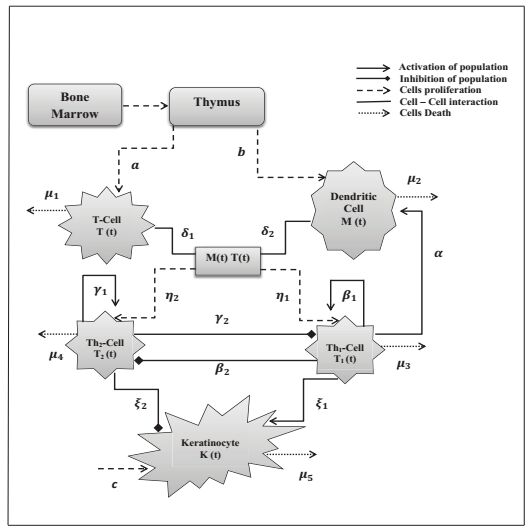
 DownLoad:
DownLoad: 